
About UsThe Numismatic Bibliomania Society is a non-profit organization promoting numismatic literature. For more information please see our web site at coinbooks.org SubscriptionsThose wishing to become new E-Sylum subscribers (or wishing to Unsubscribe) can go to the following web page link MembershipThere is a membership application available on the web site Membership Application To join, print the application and return it with your check to the address printed on the application. Membership is only $15 to addresses in the U.S., $20 for First Class mail, and $25 elsewhere. For those without web access, write to: David M. Sundman, Treasurer AsylumFor Asylum mailing address changes and other membership questions, contact David at this email address: dsundman@LittletonCoin.com SubmissionsTo submit items for publication in The E-Sylum, just Reply to this message, or write to the Editor at this address: whomren@gmail.com
BUY THE BOOK BEFORE THE COIN |
- WAYNE'S WORDS: THE E-SYLUM DECEMBER 22, 2013
- NEW BOOK: A CATALOG OF GEORGIAN COINS
- NEW BOOK: HANDBOOK OF CURRENT CIRCULATING COINS OF THE WORLD
- EL SITIO NO. 9 PUBLISHED
- SPECIAL EDITION NUMISMATIC AUCTION CATALOGS
- REVIEW: JOURNAL OF NUMISMATIC RESEARCH, SPRING 2013
- EARLY COIN DEALER PHONE NUMBERS
- NOTES FROM E-SYLUM READERS: DECEMBER 22, 2013
- ON USING THE SERIAL COMMA
- SOMETIMES YOU HAVE TO SEE THE COIN
- COLLECTING GOLD COINS DURING MILTON A. HOLMES’ TIME
- RON ABLER ON THE NUMISMATIC IBOOK
- MORE ON THE WASHINGTON'S HEADQUARTERS COIN HOARD
- MORE NUMISMATIC POSTCARDS
- QUERY: 1996 SALVADORIAN 5-COLÓN BI-METALLIC COIN IMAGE SOUGHT
- MORE ON THE LOOTING OF NAPLES' GIROLAMINI LIBRARY
- SULPHUR, LOUISIANA'S CENTENNIAL MEDAL
- MORE PHYSICAL BITCOINS
- THE KÜNKER AUCTION SALE NO. 244
- ISRAEL MUSEUM ACQUIRES WORLD’S ‘FIRST JEWISH COIN’
- BANK OF ENGLAND TO ISSUE POLYMER BANKNOTE
- THE ONS' BEST AND WORST IN NUMISMATICS
- MORE TURKEYS IN NUMISMATICS
- FEATURED WEB SITE: BRITISH ASSOCIATION OF NUMISMATIC SOCIETIES
Click here to access the complete archive
To comment or submit articles, reply to whomren@gmail.com
WAYNE'S WORDS: THE E-SYLUM DECEMBER 22, 2013

New subscribers this week include William Myers, courtesy of Howard Daniel, Merle Avila, courtesy of Alan Weinberg, and Joseph Ursich. Welcome aboard! We have 1,684 email subscribers, plus 257 followers on Facebook.
This week we open with information on three new books and periodicals, and my review of the Spring 2013 issue of the Journal of Numismatic Research. Other topics include studying coins from photos vs. in-person, collecting gold coins in the post Gold Act era, the Washington's Headquarters coin hoard, and the Bank of England's announcement of a switch to polymer banknotes.
To learn more about Georgian coins, special edition numismatic auction catalogs, Benjamin Franklin Peale's innovations, early coin dealer phone numbers, more numismatic postcards, Turkeys in Numismatics and the Sulphur Centennial Commemorative Coin, read on. Have a great week, everyone! Merry Christmas and Happy New Year 1902-1903.
Wayne Homren
Editor, The E-Sylum
NEW BOOK: A CATALOG OF GEORGIAN COINS
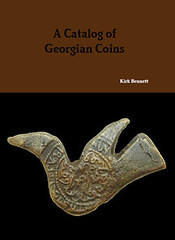 A CATALOG OF GEORGIAN COINS
A CATALOG OF GEORGIAN COINS
by Kirk Bennett
Available In January 2014
Reserve your copy today!
This eagerly anticipated publication will quickly become the standard reference for coins of Georgia across all time periods. No numismatic library will be complete without this volume!
DETAILS
- Hardcover
- 341 Pages
- Images For Many Listings
- $79 per copy
POSTAGE & HANDLING
USA Any Quantity Free USPS Media Mail
International 1 Copy $32 USPS First-Class Mail
International 2-3 Copies $60 USPS Priority Mail
International 4-5 Copies $78 USPS Priority Mail
International 6+ Copies Contact Us USPS Priority Mail
Alternative shipping methods available upon request.
We will also be able to deliver copies at the NYINC coin show on January 9-12, 2014. Please specify when placing your order if you wish to pick up the book at the show.
To reserve your copy, send an email to: orders@stevealbum.com
Please note that your order may take a few days to process due to the holiday season. We thank you in advance for your patience awaiting your invoice.
STEPHEN ALBUM RARE COINS
PO Box 7386
Santa Rosa, CA 95407 USA
mike@stevealbum.com http://www.stevealbum.com
707-539-2120 phone
707-539-3348 fax
NEW BOOK: HANDBOOK OF CURRENT CIRCULATING COINS OF THE WORLD
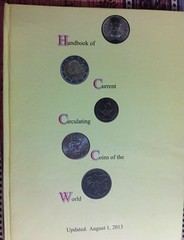 Ultramodern numismatist Pabitra Saha writes:
Ultramodern numismatist Pabitra Saha writes:
My notes have been printed in a book form by my club, "The Coin Club". It covers 204 countries in 160 pages. The book is printed on high quality art paper, is hard bound and weighs 840 grams. Since the number of members in the club is less than minimum print run, a limited number of copies are available for sale to non-members.
The cost of book is 25 Euro, will be despatched from Antwerp, Belgium. The packing & postage would be 15 Euro for EU countries in mainland Europe and 20 Euro for rest of the world.
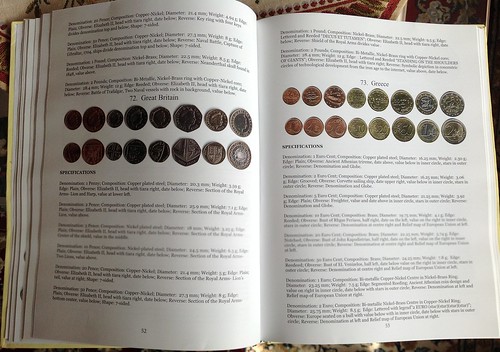
He adds:
Those who are interested can mail me and I will coordinate the receipt of payment and despatch of the book. I will also ensure that when the copies are exhausted, the intending buyers are duly informed. Later, they will be updated if alternate arrangements for printing more copies are made.
EL SITIO NO. 9 PUBLISHED
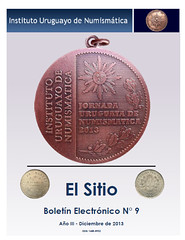 “El Sitio” Nº 9 contains, in its 20 pages, three numismatic articles, a note on an exposition and conference, and the Chronic of the Uruguayan Convention of Numismatic 2013; this latter, key issue of the journal. The Convention was held on October 19th in the Club Español (Spanish Club) in Montevideo city, the capital of Uruguay. This was the first Convention in Uruguay after an extremely long period of time, and made that more than 300 people (collectors, numismatists and sellers of Uruguay, Argentina and Brazil) gathered together with the aim of meeting and sharing the passion for numismatics.
“El Sitio” Nº 9 contains, in its 20 pages, three numismatic articles, a note on an exposition and conference, and the Chronic of the Uruguayan Convention of Numismatic 2013; this latter, key issue of the journal. The Convention was held on October 19th in the Club Español (Spanish Club) in Montevideo city, the capital of Uruguay. This was the first Convention in Uruguay after an extremely long period of time, and made that more than 300 people (collectors, numismatists and sellers of Uruguay, Argentina and Brazil) gathered together with the aim of meeting and sharing the passion for numismatics.
The cover of “El Sitio” Nº 9 shows the picture of the obverse of the medal commemorating the Uruguayan Convention of Numismatic 2013, made by the famous house mint Tammaro, founded in 1885 still an emblematic business nowadays.
The three published articles are the following:
- The 1903 Medal remembering a soccer feat of the National Club of Football, by Juan José Melos Prieto.
- The medals of Confitería Irisarri in Minas, by Daniel Padula.
- The tokens of the Soba Runch in Río Negro, by Daniel Fernández Calvo.
The numismatics exposition, that took place in the head office of the Instituto Uruguayo de Numimática, was about cobs coins and its speaker was Carlos Deambrosis.
To read the complete issue, see: www.monedasuruguay.com/bib/bib/sitio09.pdf

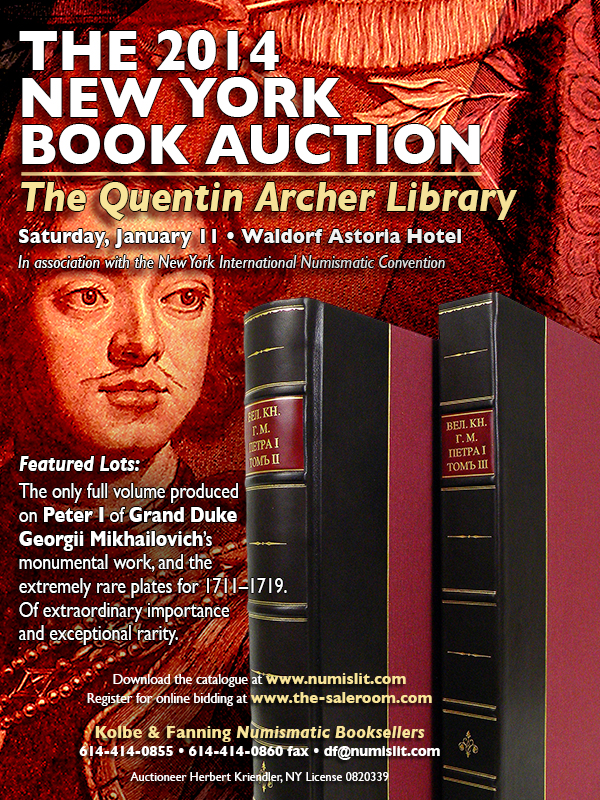
SPECIAL EDITION NUMISMATIC AUCTION CATALOGS
Special editions of numismatic auction catalogs have been produced since the middle of the 19th century, when the hobby in this country was in its infancy. Early special editions were often printed on thicker or larger paper, and were frequently hand-priced as well (the printed prices realized list being a somewhat later development). In the absence of printed price guides, hand-priced catalogs were the “Red Books” of their day, allowing collectors to get some sense not only of the value of collectible coins but also of what coins even existed.
As the hobby developed, things changed. By the end of the century, a number of dealers were publishing occasional price guides, and collectors were somewhat less reliant on hand-priced auction catalogs to determine value. But other features were beginning to appear in these catalogs. The use of photographic plates began with the June 1869 Edward Cogan catalog of the Mortimer Mackenzie Collection, but became more common in the 1880s and 1890s. Generally, these sold for a premium while unplated catalogs were distributed free.
Early plated auction catalogs are a popular collectible today and have significant utility for research purposes. The plates were produced through various photographic printing processes and their verisimilitude remains striking. Unlike today’s halftone images, which dissolve into a series of dots under magnification, the older heliotypes, collotypes and other photographic plates can be magnified for examination of detail, assisting with provenance research and die studies.
By the 1930s, catalogs with photographically printed plates were rarities, as the halftone process had developed as a less expensive, if less useful, method of illustrating coins for sale. The period between the 1930s and 1950s is not known for the excellence of its catalogs, but there were exceptions. The Stack’s firm began issuing the occasional special edition hardcover catalog with its 1940 sale of the A.C. Gies Collection. Abe Kosoff and other firms adopted the practice of issuing limited edition hardcover catalogs, though these were usually reserved for especially notable sales.
With their January 1986 offering of the Ezra Cole Collection, the firm of Bowers & Merena began issuing limited edition hardcover catalogs for all of its sales, available on a subscription basis. This practice gradually became more common, with Superior and Stack’s issuing hardcovers for most of their sales by the 1990s. In the subsequent era of consolidation, however, the number of firms offering such productions dropped.
Why produce or collect special edition hardcover catalogs? Part of it is simply aesthetics: They look nicer on a shelf. A more practical reason is that hardcover catalogs better preserve their contents. We have all grown familiar with the typical numismatic auction catalog of today: printed in an 8.5- by 11-inch format on heavy clay-based coated stock. There are advantages to this type of catalog: The larger size provides for a more attractive layout, and the coated paper is ideal for color photos. But there are also drawbacks: They are heavy, and when standing vertically on a shelf for a long period of time they tend to collapse under their own weight. The “perfect” binding eventually proves to be anything but, and pages start to come loose.
These drawbacks are ameliorated in a hardcover catalog: The boards prevent the catalog from folding under itself and the increased strength of the binding stands up to the pressures exerted upon it. These features make special edition hardcovers popular, especially for important sales.
To read the complete article, see: Special edition numismatic auction catalogs offer benefits (www.coinworld.com/articles/special-edition-numismatic-auction-catalogs-o)
REVIEW: JOURNAL OF NUMISMATIC RESEARCH, SPRING 2013
Roger Burdette produces a wonderful periodical, the Journal of Numismatic Research. The Spring 2013 issue focuses on the work of Benjamin Franklin Peale. Here's the description from the Wizard Coin Supply web site:
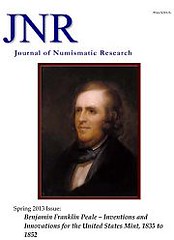 Journal of Numismatic Research -- Issue 2 -- Spring 2013 (Benjamin Franklin Peale)
Journal of Numismatic Research -- Issue 2 -- Spring 2013 (Benjamin Franklin Peale)
Author / Editor: Roger W. Burdette
ISBN 13: 9780976898689
UPC: 9780976898689
Our Price: $20.00
The Spring 2013 JNR is 135 pages of detailed articles and rarely seen illustrations covering the work of Benjamin Franklin Peale. Most collectors recognize Peale as inventor of the steam powered press introduced at the Mint in 1836. What few are aware of is the extent to which Peale’s work changed the Mint, its coining capacity and the basic nature of U.S. coins. With help from Joseph Saxton and Adam Eckfeldt, and a wealth of detailed knowledge brought back from his European mission, Peale’s inventions converted the Mint from a backward haphazard operation into a technology-leading mint. By the early 1850s, the Philadelphia Mint could produce more good coins per day than any mint in the world, and these were made at labor and equipment costs far below the best European mints.
Peale’s “magic” was a combination of insightful use of technology, and simplification. For him, the best solution to a problem was not technology alone, it was a amalgamation of human capabilities with basic mechanical principles that produced the greatest return for the least amount of money, time and energy.
Titled Benjamin Franklin Peale – Inventions and Innovations for the United States Mint, 1835 to 1852, this magnificent research edition describes and illustrates every improvement and invention made by Peale for the U.S. Mint. Peale’s inventions turned the Mint from a backwater mint barely hobbling along, into the best, most modern and most economical national mint in the world.
From his well-known coinage press, to blank cutters, furnaces, electrotyping, die manufacturer, balances, hiring female employees, rolling mills, upsetting machines, coin counters - the list goes on and on, Franklin Peale literally reinvented the US Mint's equipment and operation.
This is a hefty issue, printed on heavy glossy paper as with previous JNR issues. While not a mainstream numismatic publication, the journal has much to offer casual readers and collectors in addition to the numismatic researcher crowd. This issue has a lot of great reading material.
PAGE 9: BENJAMIN FRANKLIN PEALE – INVENTIONS AND IMPROVEMENTS FOR THE UNITED STATES MINT, 1835 TO 1852 by Roger W. Burdette
PAGE 13: IMPROVEMENTS IN THE METHOD OF MAKING WORKING DIES AND REDUCTIONS – 1835
PAGE 23: IMPROVEMENTS IN ASSAYING AND PARTING SILVER, AND RECOVERING PRECIOUS METALS FROM WASTE WATER – 1835
PAGE 27: INVENTION OF A TOGGLE-JOINT COINAGE PRESS – 1835
PAGE 38: IMPROVEMENTS IN ROLLING, DRAWING AND ANNEALING – 1835-1839
PAGE 49:
INVENTION OF THE ECCENTRIC DRIVE BLANK CUT-TING PRESS – 1836 PAGE 57: INVENTION OF THE UPSETTING MACHINE – 1836
PAGE 63: IMPROVEMENTS OF THE PILING BOX AND COIN COUNTING BOARD – 1837 AND 1839
PAGE 71: DESIGN FOR A STEAM ENGINE – 1839
PAGE 91: IMPROVEMENT OF BALANCES – 1835-1847
PAGE 103: IMPROVEMENTS IN ELECTROTYPING FROM MODELS OF METAL, WAX AND PLASTER – 1840
When the second United States Mint opened in Philadelphia in 1833, it was a new build-ing filled with antiquated and obsolete equipment, and operated with equally outdated production practices. A steam engine had been introduced in 1817 but it did little more than power the antique rolling mill – nearly everything else was performed by horse or human power. (p9)
Franklin Peale began his service to the Mint that same year, and at the request of Director Samuel Moore, Peale sailed for Europe in May 1833 with the goal of learning everything he could about the state of the art of coining.
On his return two years later he was eager to apply his knowledge and intellect not only to bring the U.S. Mint in line with the rest of the world, but to surpass it. His recommendations and inventions took the U.S. from a third-rate operation to one of the best in the world, a leader in coin manufacturing technology.
His changes were not necessarily met with complete enthusiasm by old hands at the mint. Jacob Eckfeldt in particular had mixed feelings. “If Mr. Peale had full swing he would turn everything upside down. Why, he even talks of throwing away our costly coining presses that have done and are doing such good service, and dispensing with manpower. Yet he won’t hear of applying steam power to our old screw presses, which has been done successfully at the Royal Mint, London. He wants something better and no doubt would have it, [as] if we were starting anew.”
Peale was leapfrogging the competition, bypassing incremental improvements for wholesale changes that would improve quality and quantity by orders of magnitude. Many of Peale's key improvements are described in detail in this issue. Here's just one example:
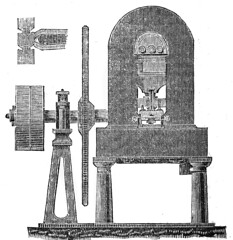 Compared to Thonnelier’s or Uhlhorn’s presses, Peale’s version makes more direct application of force and is clearly built on a more robust, compact and simplified application of the same principles. In most respects, Peale seems to have selected the best from European examples, and discarded all unnecessary complexity and ineffective motion. His coin press is simple, direct, somewhat homely in appearance, but entirely effective in operation.
Compared to Thonnelier’s or Uhlhorn’s presses, Peale’s version makes more direct application of force and is clearly built on a more robust, compact and simplified application of the same principles. In most respects, Peale seems to have selected the best from European examples, and discarded all unnecessary complexity and ineffective motion. His coin press is simple, direct, somewhat homely in appearance, but entirely effective in operation.
The basic mechanics of the press are from the same family as Peale’s blank cutting and upsetting machines. All used an eccentric to redirect rotational energy to linear force while maintaining simplicity of operation. On a broader scope, all three were components and principles used in locomotives and stationary steam engines, and these connected back to Peale’s early years working with Matthias Baldwin.
While many collectors' eyes may glaze over at descriptions of the mechanics, true numismatists will recognize the importance of Peale's innovations to the production of high quality coinage at scale. While many will lament the loss of the interesting collectible variations introduced by the earlier semi-handmade era of coin production, it was an era doomed regardless by the growth of the nation and its economy. Only high-speed methods like Peale's would be able to keep up with demand, and luckily the new systems simultaneously increased quality - the best of both worlds enabled by the new industrial age and the wit of clever mechanics like Peale.
Peale's innovations were not only mechanical - he made important operational and social changes as well. It was Peale who turned a significant portion of the coin-making process over to female employees, who proved to have greater speed and dexterity than men, and until equal pay was enforced in 1887, they worked for half the salary.
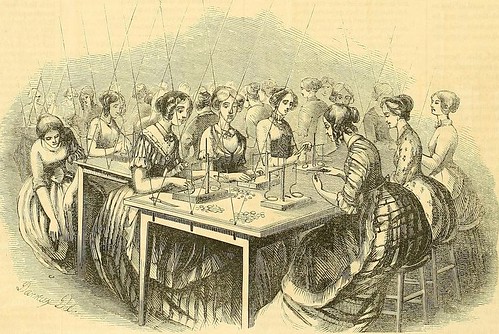
Planchet adjusters at the Philadelphia Mint, 1852
Bibliophiles will note that Peale also had a hand in creating the famous image of the Second U.S. Mint seen in Eckfeldt-DoBois' 1842 book, A Manual of Gold and Silver Coins of All Nations Struck Within the Last Century.
At the front of Eckfeldt’s book was a ruled engraving of the U.S. Mint in Philadelphia. The illustration was produced from a photograph Saxton had taken in 1841 with his daguerreotype camera pointed northward from the south side of Chestnut Street, the street toward which the Mint building faced. Christian Gobrecht, the mint’s engraver, cut an incuse relief from the daguerreotype in soft metal, and Peale made an electrotype from this incuse model. Saxton used the ruling machine on the electrotype to make an engraved printing plate.124 The names “Gobrecht” and “Saxton” can be seen below the building at left and right, respectively. (p106)
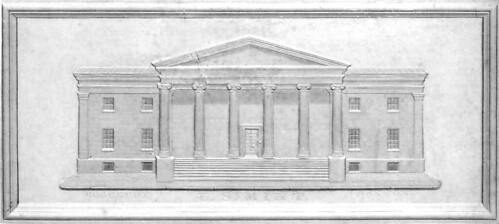
I could go on to cite a number of interesting tidbits to be found within the pages of this issue of JNR. I highly recommend it to numismatists everywhere who are curious to learn more about the nitty-gritty of how the great coins we collect today were made, and how Benjamin Franklin Peale was a key innovator at a key time in numismatic history.
To order, see: Journal of Numismatic Research -- Issue 2 -- Spring 2013 (Benjamin Franklin Peale) (www.wizardcoinsupply.com/journal-of-numismatic-research-spring-2013-benjamin-franklin-peale-inventions-and-innovations-for-the-united-states-mint-1835-1852.html)
EARLY COIN DEALER PHONE NUMBERS
Regarding phone numbers on numismatic correspondence, I found the following in my files: Scott Stamp and Coin Co. letterhead dated July 9, 1935 - "Telephone Bryant 9-1277"; Henry Chapman letterhead dated December 31,1936 - "Bell Phone, Pennypacker 7752; and The Elder Coin and Curio Corporation letterhead dated February 8, 1937, "Telephone Wisconsin 7-8687".
As a related story, many coin dealers during the 1980 silver boom had canvas bags imprinted with their name and address. We used thousands of these in the 1980s at my former work place. In 1995 when I started Chicago Coin Company I ordered canvas bags and requested my website be included under the address. The bag company is one of the larger in the country and no one had ever asked for this. They had to adjust their printing equipment and add a line. We became the first company to include a website on their canvas bags. In 2110 when someone asks the E-Sylum editor when the first website address was placed on a bank bag, this might pop up on the Google of the future.
To read the earlier E-Sylum article, see: NOTES FROM E-SYLUM READERS: DECEMBER 1, 2013 : Query: When Did Phone Numbers Become Commonplace? (www.coinbooks.org/esylum_v16n49a08.html)
NOTES FROM E-SYLUM READERS: DECEMBER 22, 2013
Howard Gibbs in Egypt Larry Dziubek writes:
Is that Howard Gibbs on the Egyptian Rolls-Royce? Does he have a gun in his waistband?
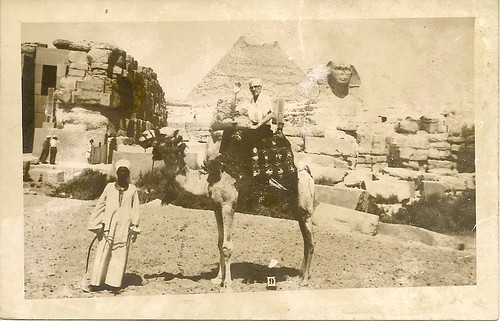
To read the earlier E-Sylum article, see: POSTCARDS AND NUMISMATICS (www.coinbooks.org/esylum_v16n51a25.html)
Bob Leuver on The E-Sylum, Bitcoins, and Jesse Owens Bob Leuver (former head of the Bureau of Engraving and Printing and the American Numismatic Association) writes:
The E-Sylum, believe it or not, is quite exciting. The personal recollections of numismatic stalwarts such as Harvey Stack and Dave Bowers and the tidbits and slightly longer recollections and comments of members re numismatic items are extremely interesting and refreshing.
Barb Gregory's The Numismatist and your E-Sylum are my enjoyable window to numismatics. Each offers a different perspective and treat different topics.
I am waiting for Ken Bressett to incorporate and write about how Bitcoins are part of numismatics. As a retired Treasury hand--now 25 years--I find it interesting that Treasury funds about 60% of the Bitcoin program. At my sister-in-law's promotion (graduation) into the senior executive service at IRS Dec. 6, I asked IRS executives how IRS will tax Bitcoin profits. No profound information.
Regarding David Ganz's photo with Jesses Owens, David wisely recounted how renowned Mr. Owens was. I was on a panel with him in 1955, in Kankakee, Il, for all KKK county high school seniors. I believe, Mr. Owens was a VP at Ford then. The two of us talked for almost 1/2 hour prior to the panel. I was just a kid when Mr. Owens and Mr. Ralph Metcalf--who later was part of the Chicago political scene, set Olympic records in '36.
To read the earlier E-Sylum article, see: E-SYLUM READERS ON MEETING JESSE OWENS (www.coinbooks.org/esylum_v16n51a21.html)
Kavan Ratnatunga on Bitcoins Kavan Ratnatunga writes:
I do not understand the details on how the BitCoins system works. As far as I understood they are like a finite number of shares in a virtual company transacted only online.
Physical BitCoins independent of the digital representation could lead to fraud as hinted in article since you could hold the physical Bitcoins and spend the online version. I assume the real owner is as registered in the online database, and the physical Bitcoin then becomes just an independent collector's item with maybe a numismatic value and nothing else.
This Bitcoin Mint being shutdown is probably the best thing that happened to those who hold these novelty fantasy items from them.
To read the earlier E-Sylum article, see: U.S. GOVERNMENT SHUTS DOWN PHYSICAL BITCOIN MINTER (www.coinbooks.org/esylum_v16n51a14.html)
Query: Are There Fake Numismatic Books? Last week Elizabeth Hahn wrote:
Some interesting issues addressed specifically in the New Yorker article are how cases of forged antiquarian books are much less frequent because of how time consuming it can be to accurately reproduce each detail of text within such a book.
Arthur Shippee writes:
At least, they were, before the new technologies -- that's the gist of this crime, right?
To read the earlier E-Sylum article, see: THEFTS SHOCK THE RARE BOOK WORLD : LC Authenticity Symposium: A Brief Report (www.coinbooks.org/esylum_v16n51a12.html)
The Fantastic Confederate Cents The Heritage article quoted last week contains this passage:
Very little is known as fact about original Confederate cents. What is known is either 12 or 16 pieces were struck in early 1861.
Bill Eckberg writes:
YAAAARGH!!!! Right after complaining that numismatic fallacies repeated often enough become numismatic fact, the article immediately states one of the biggest whoppers ever.
Please understand that I don't mind Heritage hyping such a consignment. That's their job, and I don't mind at all if someone wants to drop a huge amount of disposable cash on one of these curiosities. But, it is absolutely NOT "known" that they "were struck in early 1861," or that they were struck for the Confederacy or that they even existed at all before their alleged discovery shortly before the first sale of one. At least I have never seen any such evidence in print. If someone has it, please publish it. Otherwise, let's just call these fantasy pieces.
To read the earlier E-Sylum article, see: ORIGINAL LOVETT CONFEDERATE CENT OFFERED BY HERITAGE (www.coinbooks.org/esylum_v16n51a11.html)
ON USING THE SERIAL COMMA
As an aside last week we discussed the proper way to use commas and conjunctions. Fred Michaelson was firmly in the "A, B, and C" camp, while I was from the "A, B and C" school.
In my corner Don Kolman writes:
I have to agree with you regarding commas and conjunctions. I was taught 60 years ago that a comma is not necessary when a conjunction is used. A, B and C is correct to me and I would have to have a English PhD tell me otherwise.
Bill Eckberg writes:
FWIW, I learned it the same way you did, and that's the way I write it.
On the other hand, Dave Schenkman writes:
I laughed when I read Fred's comments regarding serial commas. While I don’t cringe when I see them, I’ve always done it using two commas. My guide in such matters is The Chicago Manual of Style, and it says, “In a series consisting of three or more elements, the elements are separated by commas. When a conjunction joins the last two elements in a series, a comma is used before the conjunction. One of the examples given seems appropriate: “We have a choice of copper, silver, or gold.”
Stephen P. Woodland agrees. He writes:
As the editor of the Royal Canadian Numismatic Association’s electronic bulletin, NumisNotes, I am in Mr. Fred Michaelson’s corner on the use of the serial comma. I follow the conventions of the Chicago Manual of Style, 16th ed., and it is clear on the issue. Here is the relevant article for everyone’s edification:
6.18 Serial commas Items in a series are normally separated by commas. When a conjunction joins the last two elements in a series of three or more, a comma—known as the serial or series comma or the Oxford comma—should appear before the conjunction. Chicago strongly recommends this widely practiced usage, blessed by Fowler and other authorities, since it prevents ambiguity. If the last element consists of a pair joined by and, the pair should still be preceded by a serial comma and the first and (see the last two examples below).
She took a photograph of her parents, the president, and the vice president.
Before heading out the door, she took note of the typical outlines of sweet gum, ginkgo, and elm leaves.
I want no ifs, ands, or buts.
Paul put the kettle on, Don fetched the teapot, and I made tea.
Their wartime rations included cabbage, turnips, and bread and butter.
John was singing, Jean was playing guitar, and Alan was running errands and furnishing food.
However, I acknowledge every editor’s privilege to “interpret” the rules.
But so far the votes are even at 3-3. By extrapolation, than means about half of E-Sylum readers are likely idiots. I’m not sure which camp I’m in, but if you can’t decide who’s the patsy in a poker game, it’s probably you.
What do you people expect from a free publication, anyway? I guess I was comma-tose. While old habits are hard to break, I'll at least quit taking commas out of people's submissions - they just might be right. -Editor
To read the earlier E-Sylum article, see: NOTES FROM E-SYLUM READERS: DECEMBER 15, 2013 : Still More Collective Terms in Numismatics (www.coinbooks.org/esylum_v16n51a10.html)
THE BOOK BAZARRE
SOMETIMES YOU HAVE TO SEE THE COIN
I enjoyed Wayne Sayles' numismatic sleuth work regarding the coin found in Israel. That coin is likely flat and in low relief. Thus, there probably isn't much to question in his work.
But it would be a pity if the techniques were applied willy-nilly to photographs of other kinds of numismatic objects. Many coins simply aren't flat – the Byzantine scyphate series would be an example familiar to many readers. While it may seem that flatness shouldn't be a big deal, in practice it is.
Wayne has more experience than I, but I have photographed hundreds of Ancient British coins and processed thousands of images in Photoshop. These Celtic coins are seldom flat, and they simply don't photograph "right". When you place the coin convex side up, the coin sits on its rim. Thus the plane of the rim and the plane of the camera are parallel – if you set the camera up correctly. When you flip the coin over, it lands on the convex side, and flops over until it makes its peace with gravity. Now the two planes are not parallel. The effect is the same as shooting the coin from an angle. In this case, the two photos will not have the same shape. A similar affect could occur whenever a coin has appreciable relief.
Sure, the photographer could orient the coin on a "bed of sand" to eliminate the problem. But no one has the time to do it, especially if hundreds of coins need to be photographed quickly.
Photoshop processing creates its own set of problems. Coin photos usually appear with nice white surrounds, as if the coin was photographed floating in space. The fact is, someone has erased the background. Though Photoshop has amazing tools for doing this, they often don't work well on coins. The shiny metal surface fools the Photoshop algorithms, and they fail to find the edge of the coin accurately. Usually, the Photoshop worker gives up, and simply uses the eraser tool to "carve out" the coin. This manual process can result in different carves for the obverse and reverse – again made worse by the level of workload.
Often, "setting the camera up correctly" isn't possible. How many coin illustrations start as iPhone shots, grabbed hand-held at a coin show? There is no reason to presuppose the camera was set up right unless you know how the coin was actually shot.
Some coins fail to cooperate at all. Try photographing a cast coin with "cold shuts", where the metal has frozen before the mould is filled. The coin will have little holes in it, but they may not be straight-through ones. Photograph it on a white background, with the light streaming through, and the hole shows up as a nice white spot. Flip the coin over and the light no longer goes straight through, and the hole disappears.
Why all this photographic pedantry? It could save writers embarrassment if they didn't jump to conclusions. Many years ago, I published an article about a strange example of a gold Stater. It was struck from late state-dies on a flan made from very debased gold (unlike the normal examples). Almost immediately, another writer complained that I simply had it wrong – that the coin was just a plated example, with a copper core. A few years afterwards, at a conference, someone stood up during my presentation and shouted that the coin was just an ancient cast forgery. After a bit of to and fro, I had to shut discussion down with "I own the coin – it's not cast!" It wasn't a plated example, either.
What I suspected, is that neither of the two commentators had ever seen the coin. It had left the UK years before either of them would have been interested enough to track it down. They had only been looking at photographs, and couldn't possibly have seen the details necessary to arrive at a sensible interpretation.
My warning to would-be authors is: SOMETIMES YOU HAVE TO SEE THE COIN.
To read the earlier E-Sylum article, see: PHOTO SLEUTH SAYLES QUESTIONS COIN FIND REPORT (www.coinbooks.org/esylum_v16n51a22.html)
COLLECTING GOLD COINS DURING MILTON A. HOLMES’ TIME
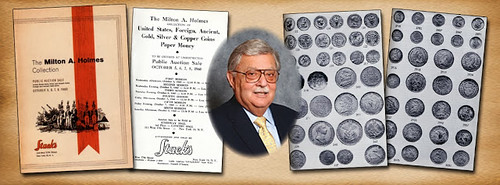
The Gold Acts of 1933 and 1934 were threatening to many who held gold coins whether as collectibles or as investments. These laws said that the gold coins in circulation had to be surrendered to the Treasury. The holding of gold coins for their gold value was prohibited, and could result in fines of up to $10,000. However, there was an exception.
The Secretary of the Treasury, a close friend and advisor of President Franklin Delano Roosevelt, was a collector of coins and loved gold coins. He had an exemption put into the law that said gold coins that were part of a collection could be retained without breaking the law. Many who owned gold coins expanded their holdings and called them "Collections" in order to hold onto their coins. The law permitted collecting of different dates and mints of all denominations. That is the reason many old time collections had incomplete series -- it provided an excuse to hold on to gold coins.
It was in this atmosphere that Milton A Holmes built his collection of gold coins. His United States gold coin collection had a large variety of dates and mints of all series. He and other “collectors” of the day provided a great service to collectors of today. While huge quantities of gold coins were surrendered to the government during this period, those who were able to save their gold coins in collections kept United States gold coins from being prohibitively rare and expensive.
The Milton A. Holmes Collection of Gold Coins of the United States comprised over 1,000 specimens sold in Stack’s 1960 auction. These were then passed on through the generations to present day gold coin collectors. Next week I will give an overview of the gold coins that were part of that collection sale.
To read the complete article, see:
Old Time Collections Part 4
(www.stacksbowers.com/NewsMedia/Blogs/TabId/780/ArtMID
/2678/ArticleID/64259/Old-Time-Collections-Part-4.aspx)
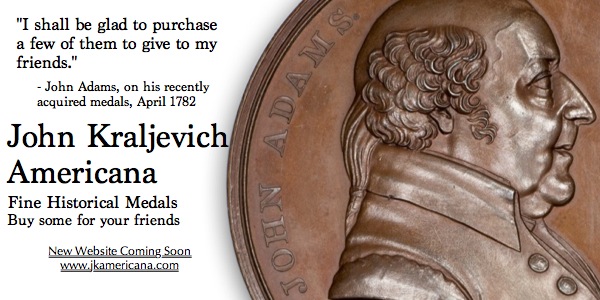
RON ABLER ON THE NUMISMATIC IBOOK
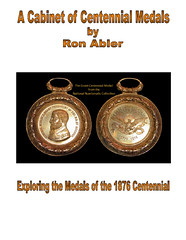 I realize that I’m late in responding to your query re publishing tools and formats. Part of the reason I am tardy is that I have been kept very busy with emails from my iBook (Internet Book) A Centennial Cabinet. I am now officially behind my own self-imposed schedule to publish the third edition of the iBook, because of the unexpected number of additions and corrections that fellow collectors have offered.
I realize that I’m late in responding to your query re publishing tools and formats. Part of the reason I am tardy is that I have been kept very busy with emails from my iBook (Internet Book) A Centennial Cabinet. I am now officially behind my own self-imposed schedule to publish the third edition of the iBook, because of the unexpected number of additions and corrections that fellow collectors have offered.
I feel strongly about the concept of an iBook as a publishing format. Unlike an eBook, my iBook is integrated into a website such that it shares the pros (and cons) of a traditional paper book and a interactive dynamic website.
Among the advantages of an iBook, as I see them, are:
1. An iBook can be cost-effectively published even when the expected audience is too small to be attractive to traditional publishers (e.g., Whitman, Krause, etc.). My only out-of-pocket costs so far for A Centennial Cabinet have been for the Adobe Acrobat Pro software, plus $100 per year for the web hosting, and $12 per year for the domain name. This does not count the $1,200 for publishing rights to the images of eight medals in the American Numismatic Society collection, because that would have been required for any publishing format.
2. The iBook itself consists of 31 PDF documents, which can be browsed online, or downloaded, saved locally, and browsed offline. They can even be printed for personal use, if desired.
3. The illustrations are almost all in full color and, in most cases, in high enough resolution to be greatly enlarged up to and exceeding full screen size, thus facilitating detailed study as desired.
4. The website itself serves four purposes, not available with other book formats:
a. It makes the iBook available to any and all readers without charge (assuming they have Internet access).
b. It serves as the navigator through the book, one PDF at a time.
c. It provides a Collectors’ Forum for interactive discussion among interested collectors.
d. It offers direct email access to the author for questions, suggestions, corrections, and additions.
5. An iBook can be updated as frequently as desired at no additional cost other than labor. This is especially important for a catalog, whose very publication, frozen on paper, guarantees that it will immediately be outdated by the first error noted or the first new addition discovered. The high cost of updating a printed catalog is often too prohibitive to be practical. There are far more first editions than second editions.
6. Even eBooks have high up-front costs, not only for the first edition, but also for subsequent editions. In some cases, such as mine, the up-front cost would probably have been greater than any likely profit from sales. In fact, I was ready to do that when Dave Schenkman convinced me that giving the book away on the web would save me money in the end. It has!
7. Finally, if the demand and the opportunity to publish a traditional physical book arises, I can easily and quickly (relatively speaking, at least) submit the 31 source documents to a publisher.
Since an iBook is a compromise, there are, inevitably, some disadvantages:
1. Not all potential readers have convenient Internet access. I hope to offer the entire book (i.e., the PDF documents) on a CD at some cost, with the understanding that the version on the CD will only be the latest version at the time of creation. Of course, this would still require a computer. I am also considering offering the book, printed (and bound if desired) at a copy shop and then mailed, upon prepaid order – no computer required. The iBook itself will continue to be revised as opportunity provides.
2. Some of the PDF files are quite large and do take some time to download. This is a function of my hosting website (faster sites are available at higher cost), as well as the reader’s Internet connection and computer speed. One solution would be to save the downloaded files and browse them locally. The files can then be updated as desired with later downloads.
3. In order to take advantage of Adobe Reader’s page-down feature, each medal in the iBook begins on a new page. This increases the total number of pages. If the book ever goes to a paper publisher, those pages will be closed up.
4. The iBook currently lacks an index. This will make a worthy addition if I can figure out how to do it, given the dynamic nature of an iBook. In the meantime, electronic search is limited to that available within a PDF.
All in all, I’m happy with an iBook. It’s not for everyone, and it’s not for every book, but it’s certainly right for me.
To read the earlier E-Sylum articles, see:
TOOLS AND TIPS FOR NUMISMATIC PUBLISHERS
(www.coinbooks.org/esylum_v16n51a15.html)
NEW BOOK: A CABINET OF CENTENNIAL MEDALS
(www.coinbooks.org/esylum_v16n47a03.html)
MORE ON THE WASHINGTON'S HEADQUARTERS COIN HOARD
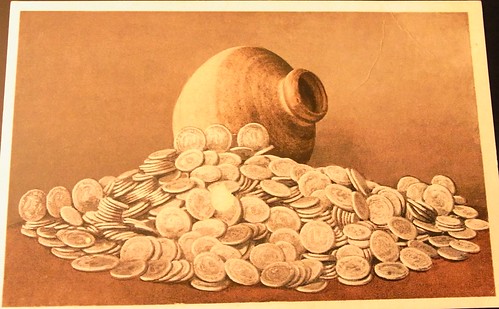
Regarding Tom Kays' old postcard of an oja and Spanish Colonial coins, Phil Flemming of Scottsdale, AZ writes:
According to information from the State Museum of New York at Newburgh, Washington's Headquarters, a hoard of about 650 Spanish Colonial coins was found on nearby private land by a local landowner named Silas Corwin on Nov. 12, 1869. Disposition of the hoard is unknown but about 32 coins from it (accession # 1971.347) came into the possession of the Museum at Newburgh, where they can still be seen photographically and sometimes on current exhibit.
A quick look-through by obliging museum personnel notes Mexico City 8 reales (columnarios) from 1733 to 1771. Contact ronna.dixson@parks.ny.gov for further information. It's an interesting Revolutionary War emergency hoard that is apparently unpublished and unnoted in Kleeberg's Numismatic Finds of the Americas (2009).
Kay Olson Freeman writes:
The post card caption says "The Jug" which was found 1869. "Jug" is the operative word. The Jug is all that was left - the coins were put in the picture and are not the originals. The coins were dispersed by the time the post card was made.
First, I was very happy to learn online about the history of the Detroit Publishing Co, which used that name 1904/1905 until 1924 (possibly even until 1932).
The State Museum, Newburgh, NY, opened its Colonial Revival style building May 27, 1910. It contained many Revolutionary War artifacts. Views of the Museum's interiors are shown on other Detroit Publishing Co. postcards which have the same reverse/address side as the Jug/ Spanish Dollars card.
This State Museum should not be confused with the nearby Hasbrouck House which was Washington's headquarters in Newburgh.
The treasure postcard was probably made to be sold in the Museum thus the card would date between 1910 and 1924. It required a 1-cent postage stamp.
Surprisingly, there is not much reporting of the treasure discovery in 1869 newspapers. The NEWBURGH JOURNAL, November 15, 1869, had the story "Discovery of Hidden Treasure." [I have shortened but added biographical info to 1869 article] In New Windsor, NY [south of Newburgh], owners of a brick yard were building a dock on the Hudson River in order to transport their bricks by ship.
The clay soil gave away and 2-1/2 feet underground they found the foot-length earthen water jar filled with 650 Spanish silver dollars dated between 1612 and 1773, There was a slight film of oxide on the coins which was cleaned off.
The owner of the brickyard was Francis F. Corwin; but his father, "Deacon" Silas Corwin (b.1789- d.1886), precipitated the accidental discovery.
Francis Corwin (b. 1822) had bought the property from Thomas Ellison, Esq, whose grandfather, William Ellison owned the property during the Revolutionary War. There are many Ellisons important in history of New Windsor and they have same first names.
It was not thought that William Ellison buried the treasure as he lived beyond the War and presumably would have retrieved it.
The treasure was found near the spot where there had been an Army storehouse during the Revolution.
At that time, New Windsor was more important than Newburgh as a supply depot. General Knox and Lafayette used the Ellison House for their HQ. George Washington did not.
The NEW YORK SUN, newspaper, May 14, 1877, wrote that Samuel Pink "found the stone pot of coin in the brick yard clay-bank of Francis F. Corwin, New Windsor, and which he [Pink] sold to historians and antiquarians for fabulous prices amassing in this one fortunate discovery $41,000."
The Yonkers HERALD STATESMAN, April 9, 1956, describes the 18-inches high, light gray clay pot now in the Newburgh Museum [formerly the State Museum]. Says several pieces-of-eight are with the pot at the Museum, but "the rest were given away by the original finder or his heirs."
Article describes discovery by Silas Corwin of Spanish pieces- of- eight which were "black with tarnish" at discovery
Article author asked Charles Hollander, NY coin dealer, about worth - perhaps $7000 or $3,00 to $12.00 each.
BROOKLYN DAILY EAGLE, June 2, 1880, names a man of Riverhead, Long Island, NY, who "has a Spanish dollar dated 1758. It is one of 600 pieces found in the diggings of a brick yard at Newburgh by Silas Corwin."
To read the earlier E-Sylum article, see: POSTCARDS AND NUMISMATICS (www.coinbooks.org/esylum_v16n51a25.html)
MORE NUMISMATIC POSTCARDS
Tom Casper writes:
I enjoyed seeing the numismatic postcards in the last issue of The E-Sylum. I also collect vintage numismatic postcards and have sent scans of a few of my favorites.
1. Denmark 500 Kroner - it has a hand written date of 1914 on the back. The card was made in Denmark
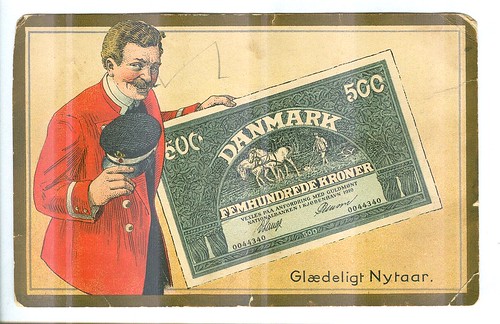
2. French 10 Francs note - circa World War 1, card was printed in Paris, France.
3. Czechoslovakia Medal - The card was printed in Chicago, IL. The medal is embossed on the card. This medal was sold at the 1939 New York's World Fair to raise money for Czechoslovakia which was taken over by Germany in 1938-1939.
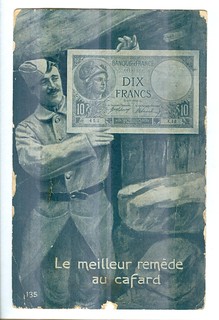
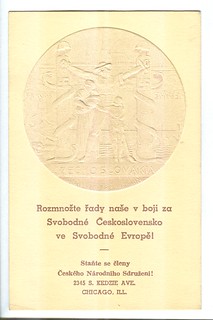
4. Lusitania Medals - The card is undated, and no publisher. Karl Goetz designed this medal. It was distributed by a Dutch company.
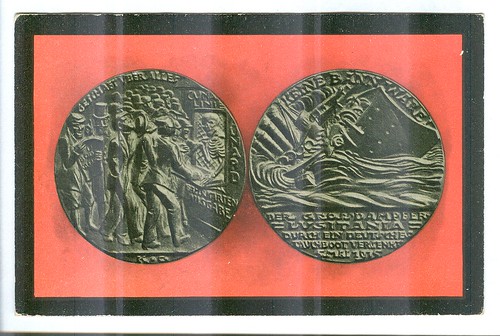

5. Scott Stamp & Coin Co. Ltd. 1893 - an early card with most of the newspaper coin ad attached missing. This card was postally used.
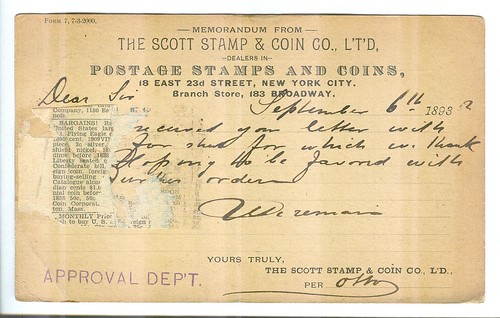
Tom adds:
I also have trade cards (circa 1880 - 1900) picturing coins and foreign currency. These were handed out by merchants for advertising purposes. People collected them for the beautiful colored pictures on the front and glued them in album which preserved them for the collectors of today.
To read the earlier E-Sylum article, see: POSTCARDS AND NUMISMATICS (www.coinbooks.org/esylum_v16n51a25.html)
THE BOOK BAZARRE
QUERY: 1996 SALVADORIAN 5-COLÓN BI-METALLIC COIN IMAGE SOUGHT
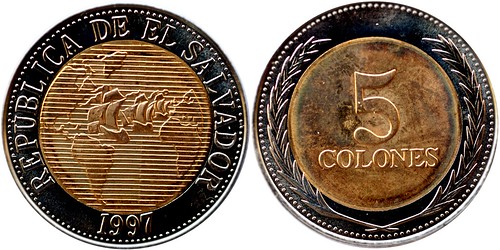
1997 5 Colones
I am again contacting The E-Sylum for assistance, which has proven very valuable in the past. I am writing a book on the Salvadorian Colon, which was discontinued at the start of the present century, after the Salvadorian economy was "dollarized".
I am now in search of an image of the never-circulated 5-Colón bi-metallic piece dated 1996. Both 1996 and 1997 dates were produced; the first one, being a presentation piece. I do have the 1997 coin, but am lacking the 1996 image.
Would anyone have this coin in his/her collection, and be willing to share the image for inclusion in the book? Needless to say, I would give due credit to the owner.
MORE ON THE LOOTING OF NAPLES' GIROLAMINI LIBRARY
 Inside a 16th Century church complex in the heart of Naples, the Biblioteca Girolamini's wooden shelves rise up and up towards richly decorated walls and vaulted ceilings.
Inside a 16th Century church complex in the heart of Naples, the Biblioteca Girolamini's wooden shelves rise up and up towards richly decorated walls and vaulted ceilings.
They once held works of extraordinary value. There was a 1518 edition of Thomas More's brilliant and mysterious Utopia. Galileo's 1610 treatise Sidereus Nuncius, containing more than 70 drawings of the moon and the stars. And Johannes Kepler's study of the motions of Mars, Astronomia Nova, described as one of greatest books in the history of astronomy.
But this magnificent piece of Italy's cultural heritage was methodically plundered. Thousands of antique texts disappeared.
"Our investigations found that there was a true criminal system in action," says Major Antonio Coppola, a police chief who is leading the operation to recover the stolen texts. "A group of people... carried out a devastating, systematic looting of the library."
"There were books spread around everywhere - on the floor, on the stairs, on tables. There was garbage - soda cans and papers - on the floor. It was total confusion, a situation of major decay. One of the library's members of staff took me aside, away from the CCTV cameras, and said: 'Professor, the director has been looting the library!'"
The director was Marino Massimo de Caro.
Montanari wrote an article for the Il Fatto Quotidiano newspaper, arguing that having De Caro as librarian was like having an arsonist in charge of a forest.
To read the complete article, see: Naples' Girolamini: The looting of a 16th Century library (www.bbc.co.uk/news/magazine-25403595)
To read the earlier E-Sylum article, see: GIROLAMINI LIBRARY BOOK THEFTS (www.coinbooks.org/esylum_v16n51a13.html)
SULPHUR, LOUISIANA'S CENTENNIAL MEDAL
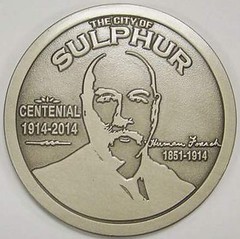

The Sulphur Centennial Commemorative Coin is now available for purchase. According to Mayor Chris Duncan, the coin's first run of 300 is complete and the coins are on sale now at City Hall for $20 each.
The antique nickel coin, featuring a likeness of sulphur mining pioneer Herman Frasch on one side and the City of Sulphur logo on the other, measures 2 1/2 inches in diameter and a quarter of inch in thickness.
Coins numbered 1-10 are being held in reserve and will be auctioned off at a date to be announced. The remaining numbered coins are available but no requests for specific issue numbers will be entertained.
"We are selling the coins on a first-come first-served basis," Duncan told the Southwest Daily News.
To read the complete article, see: Sulphur Centennial coins now available (www.sulphurdailynews.com/article/20131216/NEWS/131219782/1994)

MORE PHYSICAL BITCOINS
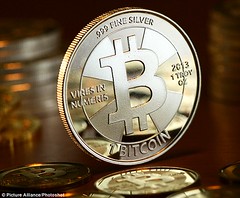 Dick Hanscom forwarded this article from the Daily Mail about Bitcoins in Norway. But it wasn't the story that caught y eye, it was the images. Last week we had an article about physical Bitcoins. This one pictures two more physical items, a silver bullion piece and a "Luci Loot" paper note. Does anyone know anything about these?
-Editor
Dick Hanscom forwarded this article from the Daily Mail about Bitcoins in Norway. But it wasn't the story that caught y eye, it was the images. Last week we had an article about physical Bitcoins. This one pictures two more physical items, a silver bullion piece and a "Luci Loot" paper note. Does anyone know anything about these?
-Editor
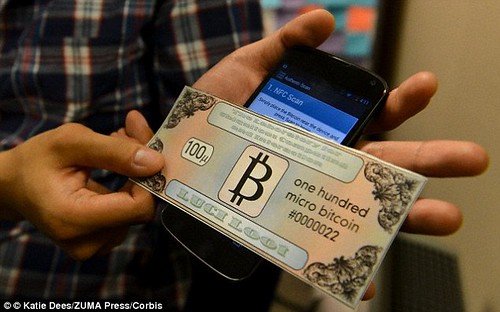
To read the complete article, see: 'Bitcoin isn't real money': Norwegian government refuses to recognise digital currency (www.dailymail.co.uk/sciencetech/article-2524672/Bitcoin-isnt-real-money-Norwegian-government-refuses-recognise-digital-currency.html)
To read the earlier E-Sylum article, see: U.S. GOVERNMENT SHUTS DOWN PHYSICAL BITCOIN MINTER (www.coinbooks.org/esylum_v16n51a14.html)
THE KÜNKER AUCTION SALE NO. 244
Rarities from Germany, Europe and Russia – the Künker Berlin auction sale
On Thursday, 6th February 2014, at 10 a.m., Künker auction sale no. 244 will start at the Berlin Estrel Hotel, offering a fine selection comprising 743 lots: rarities in gold and silver from Germany, the Holy Roman Empire, Europe, the oversea countries and, most of all, Russia, will come to auction. The total estimate adds up to more than 4,5 million euros and this is a good indication that a great number of extremely rare gems will change hands.
Please note that this time the viewing procedure differs from what you are used to: the items can be viewed from 6th to 31st January 2014 in the offices of Künker in Osnabrück by prior telephone appointment. On Tuesday, 4th February 2014, the viewing will take place at Kunsthaus Lempertz, Poststrasse 22 / Berlin-Mitte. On 5th February, the lots will be available for examination at the Estrel Hotel where the Künker auction sale will open the World Money Fair the following day.
Germany The auction commences with 335 lots of coins and medals from Germany. Anyone aiming at fillings the gaps in his collection has arrived at the right place. The spectrum covers everything from Anhalt to Würzburg, offering precious objects from the different minting authorities in the finest conditions with provenances of which a number hark back quite some time. Be it an extremely rare thaler of pious John, Margrave of Brandenburg-Küstrin (29, VF-EF, estimate: 40,000 euros), a 1/2 Hamburg portugalöser from 1668-1673 (143, EF, estimate: 60,000 euros), or a konventionsthaler struck jointly by Frederick Augustus, Duke of Nassau-Usingen, and Frederick William, Prince of Weilburg, on their visit of the Ehrenbreitstein Mint (222, ab. FDC, estimate: 30,000 euros): Künker auction sale no. 244 presents many an important highlight of German numismatics.
A large series of Brandenburg-Prussia contains spectacular items: a reichsguldiner 1551 of Joachim II with the title of Charles V (28, VF, estimate: 25,000 euros), a Guinea ducat 1687 of the Great Elector (33, EF-FDC, estimate: 20,000 euros) and a gold medal of 45 ducats from 1883, issued on the occasion of the silver wedding of the crown princely couple Frederick William and Victoria (91, EF, estimate: 25,000 euros).
World Coins 62 lots of the Habsburg Monarchy and Austria ranging from Sigismund rich in Coin to the First Republic open the section of European coins and medals. The highlight is a gold medallion of Charles VI of 27 ducats from 1716 on the birth of Archduke Leopold, of which only two specimens are known to exist (359, EF-FDC, estimate: 30,000 euros).
The numismatic journey through Europe starts with Albania. Denmark is the first stop, with much to be learned from this country’s colonial past. Did you know that there was a Danish Christiansburg in African Guinea? A double ducat of Christian V from 1688 is a witness of that period of the Danish past (415, ab. EF, estimate: 15,000 euros). A 5 ducat piece made of guinea gold dates to 1704 (416, EF, estimate: 75,000 euros). And the Danish Asiatic Company had piasters produced in 1774, following the Spanish model, which were made for the trade with China (419, EF-FDC, estimate: 80,000 euros).
Let us stay in Copenhagen a bit longer while travelling to Greece at the same time. Impossible? Well, we will manage to do so looking at a coin of the Greek king George I, who was born as Prince of Schleswig-Holstein-Sonderburg-Glücksburg in Copenhagen in 1845. His portrait is shown on the 100 drachmae piece from 1876 of which only 76 examples were made (439, ab. EF, estimate: 40,000 euros). The original mintage of the thaler of Antonio Maria Tizzone, Count of Desana isn’t known for sure – only that the specimens are extremely rare today, particularly when coming in such a state of preservation as the one presented by Künker (455, EF-FDC, estimate: 30,000 euros). A thick 6 scudi piece from Genoa from 1719, depicting the Madonna on its obverse and an embellished cross on the reverse, is a unique specimen (456, VF, estimate: 35,000 euros). The unchallenged highlight of the Italian section of Künker auction sale 244 is a gorgeous 10 zecchini piece from 1677, minted in Retegno at the behest of Antonio Theodoro Trivulzio (468, EF, estimate: 100,000 euros).
From Poland come only 29 coins – but these coins have no peer! The pre-sale estimates of these 29 items add up to more than 600,000 euros! The most expensive Polish coin is a 5 ducat piece from 1614, minted in Bromberg in 1614. This object, in all probability a unique specimen, depicts a magnificent portrait of Sigismund III (520, VF, estimate: 80,000 euros).
Let us conclude our numismatic journey through Europe with a 10 ducat piece of George I Rakoczi, Prince of Transsylvania, who took advantage of the distress the House of Habsburg was in during the 30 Years’ War to gain control over major parts of Hungary (586, EF, estimate: 40,000 euros).
The oversea countries have many a thrilling piece to offer, too, like a splendid achievement medal of the Fort William College, which the English East India Company had founded. That medal was awarded to brilliant William Waterfield for his achievements regarding the study of Hindi language. Waterfield was the one that made a great deal of literature from the Indian sub-continent widely known thanks to his congenial translations he made during his career in the British civil service of India (598, EF-FDC, estimate: 12,500 euros).
Russia 129 lots comprising Russian rarities, ranging from Alexei Michailovich to the Russian Republic conclude the auction. The most expensive piece is a test strike of a rouble from 1801, struck in the Imperial Bank Mint of St. Peterburg. This great rarity comes with an expert report written by Igor Schiryakov of the State Historical Museum Moscow (678, VF, estimate: 75,000 euros).
Last but not least: let’s mention a magnificent gold medal of 20 ducats of Peter the Great from 1801, showing Hercules carrying the orb on his reverse (634, EF-FDC, Estimate: 30,000 euros) and a platinum coin of Tsar Nicholas I from 1837, of which only 53 examples were produced (687, PP, estimate: 40,000 euros).
The catalogs may be requested at Künker, Gutenbergstrasse 23, D-49 076 Osnabrück; phone 0541 / 96 20 20; fax 0541 / 96 20 222; or via email: service@kuenker.de. All coins can be found online, four weeks prior to the sale, at www.kuenker.de/Unsere_Auktionen.Kuenker
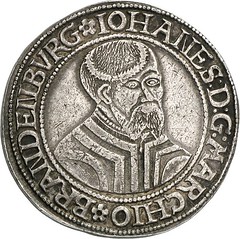
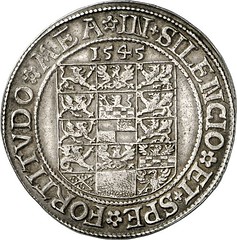
29 Brandenburg-Prussia. John of Küstrin, 1535-1571. Thaler 1545, Krossen. Dav. 8956. Very rare. Very fine to extremely fine. Estimate: 40,000 euros.
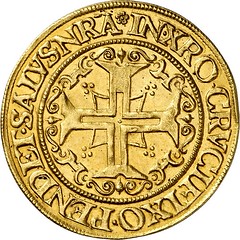
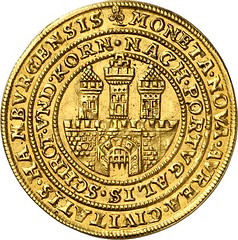
143 Hamburg. 1/2 portugalöser of 5 ducats n. y. (1668-1673), Mint master Matthias Freude. Extremely rare. Extremely fine. Estimate: 60,000 euros.

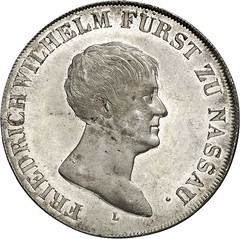
222 Nassau. Frederick Augustus of Usingen, 1803-1816, and Frederick William of Weilburg, 1806-1816. Konventionsthaler n. y. (1815) on the visit in Ehrenbreitstein. Hybrid coin. Extremely rare. Proof strike, about FDC. Estimate: 30,000 euros.
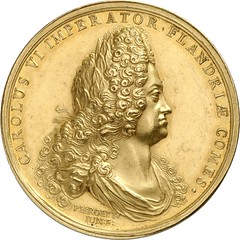
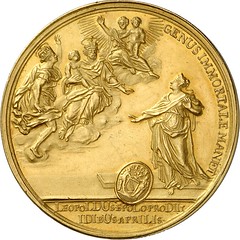
359 HRE. Charles VI, 1711-1740. Gold medallion of 27 ducats 1716 by P. Roettiers on the birth of Archduke Leopold, minted at the behest of Brügge. Kenis 3. Probably 2nd known specimen, only specimen on the market. Extremely fine to FDC. Estimate: 30,000 euros.
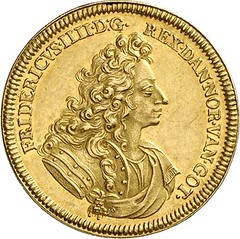
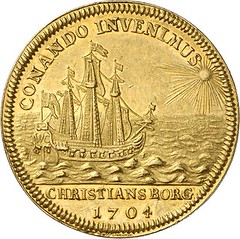
416 Denmark. Frederick IV, 1699-1730. 5 ducats 1704, Copenhagen. Fb. 246. Very rare. Extremely fine. Estimate: 75,000 euros.
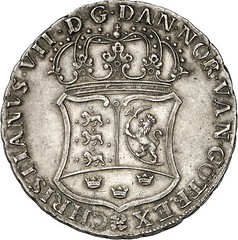
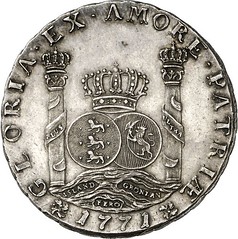
419 Denmark. Christian VII, 1766-1808. Piaster 1771 (minted in 1774), Copenhagen for the trade with China. Minted by the Danish Asiatic Company following the model of the South American 8 reales piece. Dav. 411. Extremely rare. Extremely fine to FDC. Estimate: 80,000 euros.
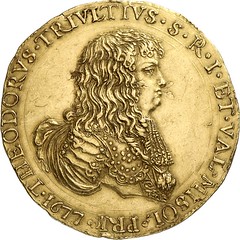

468 Italy / Retegno. Antonio Teodoro Trivulzio, 1676-1678. 10 zecchini 1677, Retegno. Fb. 986. Very rare. Extremely fine. Estimate: 100,000 euros.
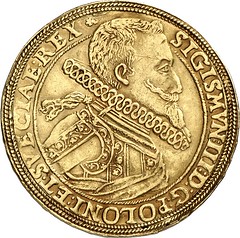
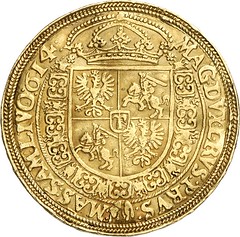
520 Poland. Sigismund III, 1587-1632. 5 ducats 1614, Bromberg. Kopicki 1326. Unique specimen. Very rare. Estimate: 80,000 euros.
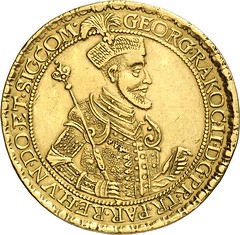
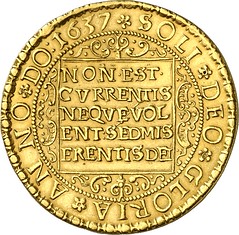
586 Hungary. George I Rakoczi, 1630-1648. 10 ducats 1637, Klausenburg. Fb. 375. Extremely rare. Extremely fine. Estimate: 40,000 euros.
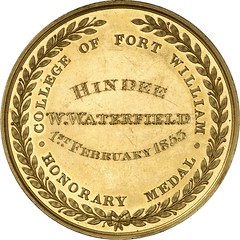
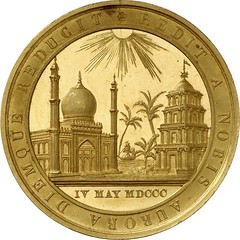
598 India. Gold achievement medal by W. Wyon n. y. (awarded in 1853) to William Waterfield for study of Hindi language. Puddester 800.5. Very rare. Extremely fine to FDC. Estimate: 12,500 euros.
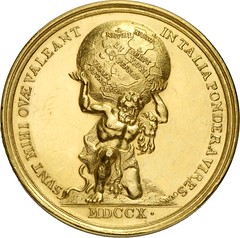
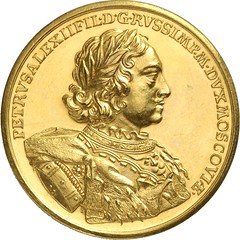
634 Russia. Peter I, 1682-1725. Gold medal of 20 ducats 1710 by P. Stadnitsky on the Russian conquests in 1710. Diakov – (cf. 38.6). Very rare. Extremely fine to FDC. Estimate: 30,000 euros.

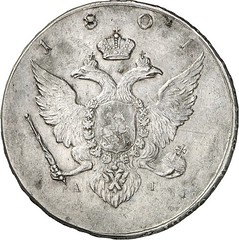
678 Russia. Alexander I, 1801-1825. Test strike of rouble 1801, St. Petersburg (Imperial Bank Mint). Bitkin 627. Extremely rare. Very fine. Estimate: 75,000 euros.
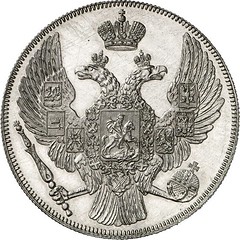
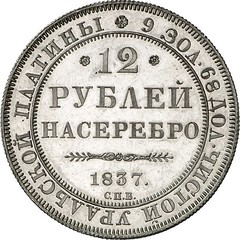
687 Russia. Nicholas I, 1825-1855. 12 rouble Platinum 1837, St. Petersburg. Fb. 158. Mintage only 53 examples. From auction sale Hirsch 22 (1959), 1060. PP, only slightly touched. Estimate: 40,000 euros.
THE BOOK BAZARRE
ISRAEL MUSEUM ACQUIRES WORLD’S ‘FIRST JEWISH COIN’
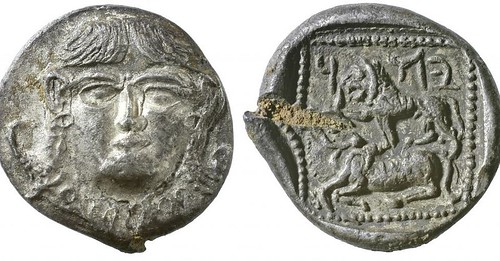
The Israel Museum has acquired over 1,200 ancient silver Persian coins, among the earliest known currency from the area, including what the museum has identified as the world’s oldest Jewish coin.
The coins, dated to the 5th and 4th centuries BCE when the region was controlled by the Persian Empire, constitute “the largest collection in the world of Persian-period coins.” The collection includes a number of previously unknown varieties, the museum said. Chief among the rare artifacts is a silver drachm, an ancient coin based upon the Greek drachma, which, in clearly legible Aramaic script, bears the word yehud, or Judea.
“It’s the earliest coin from the province of Judea,” the museum’s chief curator of archaeology, Haim Gitler, said in an interview with The Times of Israel, calling the 5th century silver drachm the “first Jewish coin.”
The coin collection dates to the period a century or more after the Achaemenid Persian Empire under Cyrus II (the Great) conquered and annexed the Neo-Babylonian Empire in 539 BCE. The Persians ruled the Levant for the next two centuries, until Alexander of Macedon stormed through and toppled their empire. Roughly a century before Persia conquered the Middle East, the earliest known currency was minted from electrum — a silver-gold alloy — in Lydia, western Asia Minor. The idea of precious metal coinage spread across the empire. Judea, Samaria and Philistia, part of the satrapy of Syria and Jerusalem, began minting their own coins shortly thereafter.
The 3.58 gram yehud coin — a hair or two lighter than today’s one shekel coin — was reportedly found in the hills southwest of Hebron and was bought at auction by New York antiquities collector Jonathan Rosen. Rosen, ”one of the world’s most important private collectors of Mesopotamian art” according to The New York Times, agreed to donate his entire collection of Persian-era coins to the museum in March 2013. The acquisition was completed in November. Apollo, an international art magazine, ranked the collection among the top museum acquisitions of 2013.
Although there are a handful of other examples of coins bearing the name Judea, Gitler said the silver drachm was a “unique coin” in its design, and was likely minted in Philistia, the coastal plain encompassing the modern cities of Ashdod, Ashkelon and Gaza, for use in the province of Jerusalem. “Only later did Judea start to mint its own coins,” he said.
A Philistian drachm from the late 5th century BCE in the collection employs a clever example of “optical trickery” in its design, he noted. When turned 90˚ counterclockwise, the lion on the coin’s reverse becomes the helmet of the bearded man, and its paws becomes the man’s hair. Gitler said such illusions were fairly common, noting that a Samarian coin from the same period showed the head of a bearded man whose face is composed of two faces in profile. Hidden owls also roost within the designs of other creatures.

To read the complete article, see: Israel Museum obtains world’s ‘first Jewish coin’ (www.timesofisrael.com/israel-museum-obtains-worlds-first-jewish-coin/)
BANK OF ENGLAND TO ISSUE POLYMER BANKNOTE
 The Bank of England is today announcing that the next £5 and £10 banknotes will be printed on polymer, a thin flexible plastic film, rather than on the cotton paper used for notes currently in issue.
The Bank of England is today announcing that the next £5 and £10 banknotes will be printed on polymer, a thin flexible plastic film, rather than on the cotton paper used for notes currently in issue.
The new polymer notes will retain the familiar look of Bank of England banknotes, including the portrait of Her Majesty the Queen and a historical character. The first polymer note will be the £5 note featuring Sir Winston Churchill and will be issued in 2016. It will be followed around a year later by a polymer £10 note featuring Jane Austen.
The decision follows a three-year research programme by the Bank looking at the materials on which banknotes are printed, and which concluded that there were compelling reasons to move to printing on polymer. In particular, the research indicated that:
Polymer banknotes are resistant to dirt and moisture so stay cleaner for longer than paper banknotes.
Polymer banknotes are secure. They incorporate advanced security features making them difficult to counterfeit and further enhancing the strong security of Bank of England banknotes.
Polymer banknotes are more durable. They last at least 2.5 times longer than paper banknotes so will take much longer to become “tatty”, improving the quality of banknotes in circulation.
In addition, polymer banknotes are more environmentally friendly and, because they last longer are, over time, cheaper than paper banknotes. Being thin and flexible they fit into wallets and purses as easily as paper banknotes.
Despite these benefits, the Bank announced in September that it would print notes on polymer only if persuaded that the public would continue to have confidence in, and be comfortable with, notes printed on polymer. A programme of public consultation was therefore a vital part of the assessment of the merits of polymer notes.
The response to that consultation was overwhelmingly supportive of polymer notes. Over the course of two months, the Bank hosted events across the United Kingdom to give the public the opportunity to learn more about polymer banknotes, to handle the notes, and to provide feedback. Nearly 13,000 individuals gave feedback during the public consultation programme. 87% of those who responded were in favour of polymer, only 6% were opposed and 7% were neutral.
To read the complete article, see: News Release - New Bank of England banknotes to be printed on polymer (www.bankofengland.co.uk/publications/Pages/news/2013/189.aspx)
E-Sylum reader Robert J. Leuver was Director of the Bureau of Engraving and Printing 1983 - 1988. I asked him for his thoughts. Bob writes:
Frankly, I was expecting this announcement. BoE had raised the issue previously. Canada has successfully launched polymer.
Polymer notes have improved since their development c1981. They are durable, more expensive to produce but are highly cost-effective due to the life of the note, and singularly secure. The US has had problems reconciling the "green" aspects of polymer, the fact that notes tend to stick together when bundled, raise concerns for ATMs, are more difficult to fold, slippery thus inducing problems when counting, and do not fare well in humid conditions. The US banknote circulates worldwide and is held by many national and third-world local banks as an asset similar to or in lieu of gold.
C 1981, BEP director Harry Clements phoned me from Australia, where he was meeting with the Four Nations Group (anti-counterfeiting: US, England, Canada and Australia). Harry was an aeronautical engineer with a strong penchant for science, then recently with Gruman. Harry was intrigued by the prospect of polymer notes. We did a quick study. We had the $10 million required for a 50% ownership. Carl Ichan would have lived the deal. However, we felt we could not sell the idea up the street at Main Treasury, nor on the Hill. We had no study or data relative to use, durability, acceptance, etc.
So, although I have not talked to Harry Clements in a long time, I am certain that he with Maurie Schneider--former BEP financial officer, and I wonder what might have been, if the BEP had a 50% interest in the highly successful and broad country use of polymer notes by Securrency--at least still owned whole or in part by Reserve Bank Australia.
EMPLOYMENT OPPORTUNITY!
Live and Work in Southern CaliforniaStack’s Bowers Galleries offers an important employment opportunity for the right person. We are seeking an experienced numismatist in the American series—coins, tokens, medals, and paper money—to work with our “dream team” of catalogers, building on the tradition of the Ford, Eliasberg, Bass, Cardinal, Norweb, Battle Born and other great collections.
If you can write in an authoritative and compelling manner with a high degree of accuracy, this may be just right for you! You will be working in Irvine, a modern community in dynamic Orange County, California—one of the finest areas to live. We offer generous benefits including medical and dental coverage, 401K plan, and more. Our offices are in our own modern, state-of-the art building with all amenities.
If you would like to be considered for this position please contact Q. David Bowers by mail or by email with your resumé, samples of your past writing (on numismatics or other subjects), and salary requirements: Mail to the attention of Q. David Bowers, PO Box 1804, Wolfeboro, NH 03894. Email to: Ckarstedt@stacksbowers.com
THE ONS' BEST AND WORST IN NUMISMATICS
- Best longest lasting design – Pistrucci St. George and the dragon,
- Best portrait – George III bullhead,
- Worst commemorative – Churchill crown (far too many produced, low relief and poor design)
- Best denomination – half crown. (Members remembered what it was like to get a halfcrown pocket money)
- Worst size- modern 5 pence - too small
- Worst metal – zinc as it turns to dust
- Worst coin error or variety- the dateless 20p
- Best reverse design –William IV halfcrown
- Best UK modern coin since 1971 - millennium 5 pounds
- Best series of coins to collect, Greek if you have deep pockets.
- Worst series to collect - most modern
- Best designer – anyone called Wyon
MORE TURKEYS IN NUMISMATICS
Jay Galst forwarded this image of a Turkey medal by Henry Weill of Medallic Art Co. 1930. Thanks!

Pabitra Saha writes:
This São Tomé e Príncipe (St Thomas and Prince) 10 dobras, 1977 with Chickens, goose, Turkey and eggs is the only coin I could locate on coins.
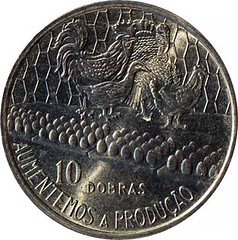
David Schenkman writes:
The E-Sylum reminded me of a turkey token I own. It was issued by TAC Banting of Cookstown (Ontario) and was good for 25¢ on a $5.00 cash purchase at his jewelry store. The reverse depicts a neat turkey and wishes merry Christmas and Happy New Year 1902-1903.
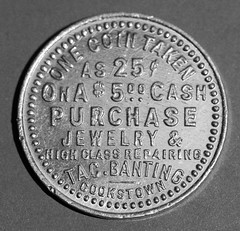
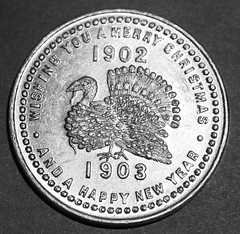
To read the earlier E-Sylum article, see: QUERY: NUMISMATIC ITEMS PICTURING TURKEYS SOUGHT (www.coinbooks.org/esylum_v16n51a24.html)
FEATURED WEB SITE: BRITISH ASSOCIATION OF NUMISMATIC SOCIETIES
This week's Featured Web Site is the British Association of Numismatic Societies.The British Association of Numismatic Societies is the national organisation which represents numismatic societies throughout the United Kingdom. It exists to promote the study of numismatics by bringing these societies and their members together to share and increase their interest and expertise in coins, tokens and currency.

www.coinclubs.freeserve.co.uk
